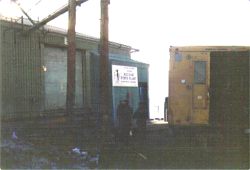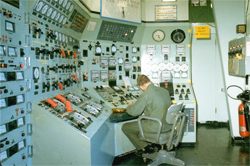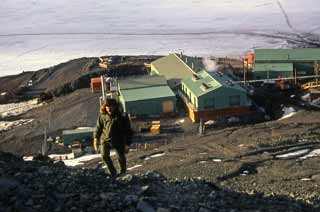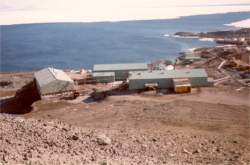The Antarctic Environmental Awareness Pages

Weddell seal near Scott
Base, December 1972
|
During the early days of the US Antarctic program, we didn't know much about the environment and the damage we were capable of doing to it. We followed the same practices as Amundsen and Scott because we didn't know any better. After all, back home we were killing off the bald eagles with DDT, having polluted rivers catch on fire, littering the summits of Everest and Denali with human waste and oxygen bottles, burying radioactive waste in open dumps, and and just starting to poison the air with lead and the ozone layer with CFC's. Eventually we learned we were damaging our world. At home, we started to clean things up. But Antarctica was a vast and remote continent, and old habits died hard. It took some adverse publicity from Greenpeace and other nongovernmental organizations, as well as a serious environmental initiative by NSF in the late 1980's, to turn things around. Suddenly a proposed Antarctic Treaty amendment to allow mining and exploitation turned into an environmental protocol to protect the continent from ourselves. It wasn't easy. After all, "we always did it this way" and "there isn't any money in the budget" are strong arguments for resisting change. Eventually the public awareness manifested itself into the capabilities and budgets to do things right. The Environmental Protocol was first approved by the Treaty nations in October 1991, but it took 5 more years before formal implementing legislation was passed by the US Congress. Official US ratification of the protocol did not occur until the implementing regulations were in place--responsibilities of the Coast Guard and the EPA as well as NSF. This occurred in April, 1997. Japan was the last nation to ratify the protocol. It took effect in January 1998. Well before then, in the early 1990's NSF and its contractor changed the environmental ways of life to conform to the new standards. Very briefly, the current regulations require that: proposed actions require environmental review and permitting activities similar to those required in the US; waste products are removed; disturbances to native plants and wildlife are to be controlled and minimized; pollution and spills are to be prevented. These pictures are from the "old days" of Antarctic life. Most of these are dimly remembered now. Let us not forget to remember our old mistakes, so we don't repeat them. 
This is the main entrance to McMurdo's nuclear power plant, PM-3A, a third of the way up Ob Hill--locally known as "nukey poo," as it was in December 1972. The idea of a nuclear plant was, of course, was to reduce the amount of diesel fuel needed for power generation, while the waste heat would later be used to operate a desalinization plant for fresh water production. The originally proposed location for the plant was on Hut Point Peninsula, but as that would have required a foundation on permafrost rather than bedrock, the actual site on the side of Observation Hill was selected. Plans called for the installation of two reactors one year apart; after the second reactor went on line, all of McMurdo was to have been converted to electric heat! Site preparation and excavation were completed during the 1960-61 season. (It so happens that the cosray lab had been erected and first used during 1959-60--in the Pass. The lab had to be moved in 1961-62 so that the neutron detectors were shielded by Ob Hill from the reactor radiation.) The plant structures and equipment were installed the following season, and the reactor first went critical on 4 March 1962. It went on line producing useful power for McM on about 12 July 1962, although its reliability was poor for the first few years. In fact, late in 1962 there was a small fire in the containment vessel due to hot hydrogen from decomposing water. The plant was officially rated at 1800 KW "gross" but its nominal "net" power generation capability for McMurdo was 1250 KW. During the 1965-66 summer the first desalinization plant was completed, it used waste heat from the reactors to create fresh water for McMurdo. This of course reduced the BTU's available for generating power; during later years the electrical power output was increased by running auxiliary boilers to operate the desal units.
Camp Century was similar in design to the "New Byrd" station of the 1960's, and the Byrd Station design originally included a similar nuclear plant; waste heat would be used for a rodwell. The long range plans also included a reactor at Pole. PM-3A was a "pressurized water reactor" which circulated one loop of water near the reactor core, and heat exchangers transferred the heat to a second water loop which drove a turbine. The reactor equipment was shipped to McM by vessel, but it was designed so that all components could fit in a C-130, as it was a prototype for Byrd and other field camps. The advertisement at right appeared in the special Antarctic issue of Scientific American published in September, 1962; I don't know if they ever started fabrication of this unit for Byrd Station; as we now know it never got delivered. (Note the wheeled forklift that is depicted in the unloading operation; I don't know the weight of the reactor unit but I'm sure it would have approached the maximum cargo load of 20,000-25,000 lbs. for C-130 shipment from McM to Byrd!) This plant was shut down in September, 1972, three months before my visit, after wet insulation was observed around the reactor pressure vessel, presumably due to leakage in the shield coolant water piping. A team from the Navy nuclear power unit came down on my flight to evaluate the repair needs; at the time everyone assumed it would be back on line quickly. Meanwhile, McM was rather short on power, because the normal summer demand was 1000-1200 KW, and the "standby" power plant (Penguin Power and Light) had 4 500 KW diesel generators of which only 2 were operational. Ah yes. As we now know, the plant was never operated again. Since chloride stress corrosion cracking was suspected, it would have been necessary to disassemble everything to inspect for cracks, and that was not practical.  At left is the control room as it looked during my visit (photo circa 1965 by Steve Kauffman). As I look at these pictures now the most amazing thing that comes to my mind is that we had just walked up to the door and were about to walk inside. (Yes, our visit had been prearranged.) There was a fence around the place and it was sometimes guarded, but not always. And after all, this was right on the main trail up the hill! Try walking into your local nuclear power plant unannounced these days!! 
At right is another 1972 view of the plant from just up the hill. Some of the buildings housed the water plant and potable water storage tanks for the desal units that used the waste heat from the reactor...or a standby boiler. This remained the main water plant for a few more years, and a standby plant on into the 1990's. 
At left is the "old water plant" as it appeared in 1988. The buildings that are missing from the previous picture are the reactor buildings which got shipped back to the US between 73-74 and 75-76. Most of the radioactive stuff ended up at the DOE's Savannah River Plant in SC. The radioactive foundation dirt went too, about 11,800 CY, between 76-77 and 78-79 (despite the fact that some of the other Ob Hill dirt was naturally radioactive...). Anyway, in May 1979 the DOE issued a final "release" that the site was cleaned up. As of 2004 the two structures in the foreground are still used for storage; the other buildings (as well as the desal equipment and tanks) have been removed. If you haven't done so yet, check out the rest of my pictures from Observation Hill here. (Reference credits for some of this information: U. S. Navy publications including various Deep Freeze (Task Force 43) cruisebooks and the Bulletin of the U. S. Antarctic Projects Officer; "McMurdo Station reactor site released for unrestricted use," Antarctic Journal, March 1980; and "Five Years of Nuclear Power at McMurdo Station," by LCDR W. G. Shafer, Antarctic Journal, March 1967.)
Somewhere near where the power plant got built eventually, here is the original McMurdo dump as it appeared on the sea ice in 1972. Hut Point is in the background. Most of the time Mother Antarctica would make all of the trash go away when the ice melted, but occasionally the ice would not break out, creating a multi-year mess. Some of what you see on the ice is plowed snow (and mixed rocks and dirt) from the streets of the town. The rest of what you see is burnables, scrap metal, old vehicles, u-barrels, drums of mixed waste oil, and other stuff that obviously attracts the skuas(?) About this time an incinerator was installed, but it was very hard to operate (for example you had to shovel the stuff in by hand) and it did not work well. Soon it was abandoned as unusable. This method of waste disposal continued until 1980, when it was discontinued partly because the sea ice refused to go out for 3 years in a row, creating a real mess--when the ice finally DID go out, it left most of the trash high and dry and in full view of the cruise ship visitors. The "Fortress Rocks Landfill" was created for nonburnables, while burnable waste was incinerated by open burning. Gradually during the 1980's more and more of the nonburnables were retrograded. In 1991 a "temporary" incinerator was installed to replace the open burning. Shortly thereafter the decision was made to ship everything out, including burnables and old stuff. The backlog content of the landfill was retrograded back to the US in the early 1990's, as is all of the trash and garbage nowadays. Food wastes are ground up in a commercial-strength waste disposal unit (a "baby grinder" as at Palmer) and mixed with the sewage. Sewage was macerated and discharged untreated into the bay until 2002-03 when the new sewage treatment plant went into operation. Next...what about the rest of the continent??... |
